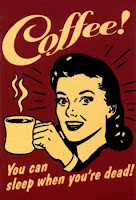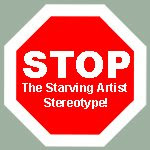
Lately, I’ve come down to the wire on a project of mine. I’ve got a week to get 6 more pages of illustrations done, a tutorial, and a painting for said tutorial. The Dr. Pepper is running freely in double doses and I long for Starbucks, which was almost single-handedly responsible for helping me survive a horrendous final quarter of grad school full of exams, portfolio reviews, and work, work, work. Now, it seems when I’m down to the wire, I always turn to that luscious brown fluid and its delicious boost of energy.
Random FYI: Did you know that Starbucks coffee contains twice the amount of caffeine of normal coffee?
But, really, is that the best strategy for making sure you beat your deadlines? I have always wondered this. Time management is, of course, a given, but even then, sometimes you’re just left without enough hours in the day to finish that chapter, that painting, or that report by the time your deadline rolls around. Coffee has been the old mainstay, but drinking too many caffeinated drinks can cause headaches, crankiness, and nervousness, which are not always conducive to getting work done.
So here are a few strategies that might work which DON’T involve ingesting enough caffeine to kill an elephant:
- Keep your blood sugar steady by eating high protein or sugary food. Natural sugars like apples and fruits are healthier, but candy is definitely quicker.
- Take a 15-20 minute catnap, depending on your preference, is just long enough to give you a little boost without tempting you to stay asleep. Personally, I have to take hour catnaps as it takes me 30 minutes to get to sleep. Da Vinci is reputed to have taken power naps in lieu of a full night’s sleep, but let’s admit it, the man was superhuman if that’s true!
- Sit and meditate for 10 minutes. Take deep breaths and clear your mind. I normally do this by sitting out in the grass of my front yard under the sun and just enjoying the tickle of grass against my bare feet and the warmth of the light. It’s more refreshing than you might think!
- If you start to nod off, make yourself get up and dance or take a 10 minute walk to get your blood flowing again. Jog up and down the stairs a few times, if there’s nowhere you can take a walk at.
- Find something to laugh about each hour. I find that YouTube is great for this and I’ve created a whole list of favorites of stupid things that make me LOL. It keeps the mind stimulated and if you’d rather do something productive for a laugh break, try watching some of the awesome art tutorials that are on YouTube. Watching tutorials not only stimulates the mind but may inspire you to get working again.
- Plan a reward for when you pass a milestone in a project or finish it. The thought of a light at the end of the tunnel, such as a nice relaxing lunch or dinner, a yummy dessert, or your favorite movie, can be a good way to motivate yourself.
- Play loud music. Bush, Disturbed, Nickelback, A Perfect Circle, Three Days Grace, Finger Eleven, Nightwish, and Nine Inch Nails have been known to serenade me through the wee hours of the night when it begins to get too hard to keep my eyes open (or when I’m trying to work off of too few hours of sleep the next day).





